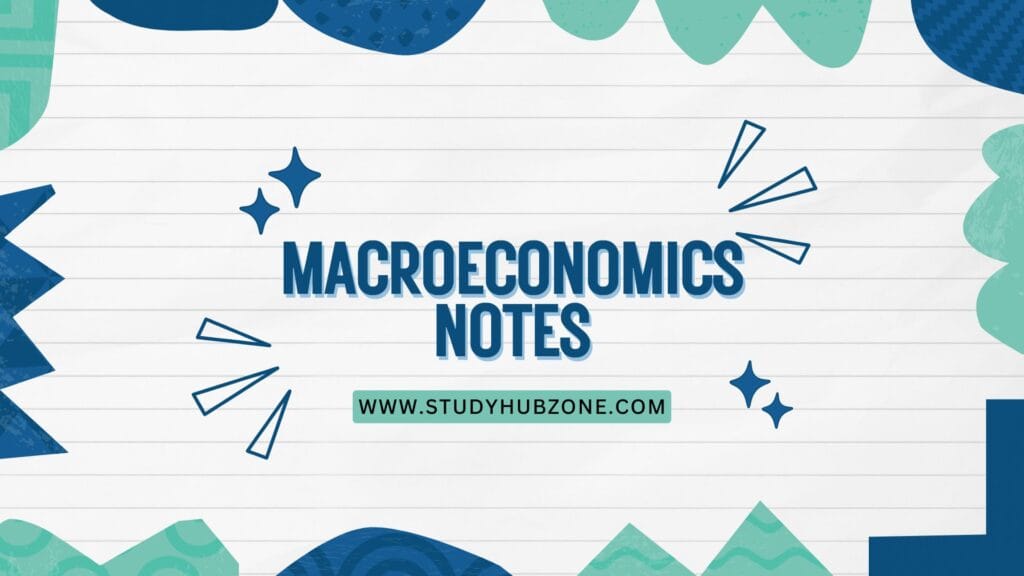
Are you searching for Macroeconomics Notes PDF to prepare for your exams? You’re in the right place! Whether you’re a BBA, B.Com, BA (Economics), BCA, or MBA student or preparing for competitive exams like UPSC, SSC, NET, RBI Grade B, or CAT, these comprehensive, easy-to-understand Macroeconomics notes are perfect for you.
In this article, you’ll get:
Free downloadable PDF notes for each unit
Clear explanations in simple English
Topics covering the complete syllabus
Best study material for quick revision
Explore the units below for detailed content. Want’s to explore more subjects – Study Hub Zone
What is Macroeconomics?
Macroeconomics is the branch of economics that studies the behavior, performance, and structure of an entire economy. It focuses on national income, inflation, employment, GDP, fiscal policy, and monetary policy, aiming to understand economic cycles and government interventions.
These notes will help you master key concepts such as:
Circular flow of income and national income accounting
Consumption, saving, and investment functions
Aggregate demand and aggregate supply
Inflation, unemployment, and business cycles
Fiscal policy and monetary policy
IS-LM Model and macroeconomic equilibrium
Why Use Our Macroeconomics Notes?
👉 100% Syllabus Covered According to University & UPSC Standards
👉 Designed for BBA/B.Com/Economics/MBA/NET/UPSC students
👉 Written by Expert Faculty & Economists
👉 Includes theoretical concepts + practical applications
👉 Perfect for Exams, Assignments, and Competitive Test Prep
Download Macroeconomics Notes PDF – Unit Wise
Click on the download buttons below to get unit-wise Macroeconomics PDF notes. All downloads are safe, free, and mobile-friendly.
Course Units
Unit 1: Introduction to Macroeconomics and National Income Accounting
Topics Covered: The meaning, scope, and limitations of macroeconomics, the difference from microeconomics, circular flow of income models (two, three, and four-sector), and national income concepts like GDP, GNP, NDP, NNP with methods of measurement.
Unit 2: Aggregate Demand, Supply, and Economic Theories
Topics Covered: The components and determinants of aggregate demand and supply, the consumption and saving functions, and compares Classical and Keynesian economics with key concepts like Say’s Law and effective demand.
Unit 3: Inflation and Price Stability
Topics Covered: Focuses on the meaning, types, causes, and effects of inflation including demand-pull and cost-push, introduces deflation and stagflation, and discusses policy tools to control inflation through monetary, fiscal, and supply-side measures.
Unit 4: Unemployment and Business Cycles
Topics Covered: Types and causes of unemployment, its impact on the economy, the Phillips Curve relationship between inflation and unemployment, and the phases, causes, and control of business cycles.
Unit 5: Monetary and Fiscal Policies in India
Topics Covered: The objectives and instruments of monetary policy (CRR, SLR, repo, reverse repo), the tools and goals of fiscal policy, and provides an overview of recent trends in India’s macroeconomic policy direction for stability and growth.
Final Thoughts
These Macroeconomics notes are carefully prepared for your academic success. Whether you’re revising before exams or trying to understand the broader aspects of the economy, these unit-wise notes are all you need.
If you find these notes helpful, please share this page with your classmates and bookmark it for future use!
Share With Your Friends!
Found this post helpful? Share it with your classmates and peers who are preparing for Macroeconomics. Knowledge grows when shared!
Got Questions or Need Help?
If you have doubts or want other subject notes like Microeconomics, Indian Economy, Public Finance, or International Economics, let us know in the comments or contact us!
